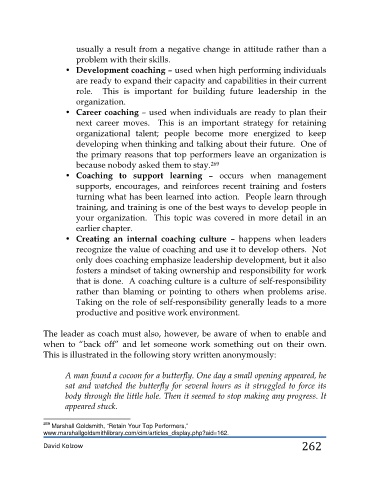Page 262 - 4- Leading_from_Within
P. 262
usually a result from a negative change in attitude rather than a
problem with their skills.
• Development coaching – used when high performing individuals
are ready to expand their capacity and capabilities in their current
role. This is important for building future leadership in the
organization.
• Career coaching – used when individuals are ready to plan their
next career moves. This is an important strategy for retaining
organizational talent; people become more energized to keep
developing when thinking and talking about their future. One of
the primary reasons that top performers leave an organization is
because nobody asked them to stay.
269
• Coaching to support learning – occurs when management
supports, encourages, and reinforces recent training and fosters
turning what has been learned into action. People learn through
training, and training is one of the best ways to develop people in
your organization. This topic was covered in more detail in an
earlier chapter.
• Creating an internal coaching culture – happens when leaders
recognize the value of coaching and use it to develop others. Not
only does coaching emphasize leadership development, but it also
fosters a mindset of taking ownership and responsibility for work
that is done. A coaching culture is a culture of self-responsibility
rather than blaming or pointing to others when problems arise.
Taking on the role of self-responsibility generally leads to a more
productive and positive work environment.
The leader as coach must also, however, be aware of when to enable and
when to “back off” and let someone work something out on their own.
This is illustrated in the following story written anonymously:
A man found a cocoon for a butterfly. One day a small opening appeared, he
sat and watched the butterfly for several hours as it struggled to force its
body through the little hole. Then it seemed to stop making any progress. It
appeared stuck.
269 Marshall Goldsmith, “Retain Your Top Performers,”
www.marshallgoldsmithlibrary.com/cim/articles_display.php?aid=162.
David Kolzow 262

